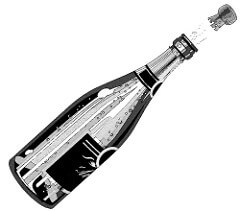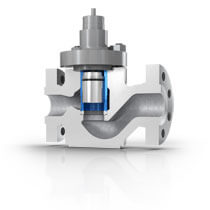Outgassing also occurs within industrial fluids containing dissolved gases experiencing a pressure drop while flowing through a control valve. Because the gas has a much lower density, and therefore larger volume than the liquid component, the flow area needs to be larger to accommodate the expanding flow volume. Additionally, the reduction in fluid density can lead to high fluid velocities that can introduce erosion and/or vibration challenges. As such, several considerations must be made when sizing/selecting a control valve for an outgassing application.
One consideration is capacity. The sudden reduction in fluid density and resultant expansion creates a need for a larger valve flow capacity (Cv). The rate of expansion is often much higher than what occurs during thermodynamic phase changes such as when water changes to steam.
Another consideration is that the expansion tends to accelerate the fluid, which now consists of a mixture of gas and liquid. This can present increased vibration levels and introduces erosion potentials for anything exposed to the fluid.
To ensure successful control valve selection, the designer must understand the dynamics of the process fluid as it passes through the valve. They must account for the volume of gas coming out of solution, and ensure that both capacity, vibration, and erosion concerns are properly addressed when selecting a control valve for outgassing applications.
I mention all this because I came across an Emerson Exchange presentation co-presented by Emerson’s Steve Brame. Their presentation looked at control valves suitable for outgassing applications. They opened noting the impact on plant performance. Incorrect consideration of outgassing in the selection of control valves for applications where dissolved gas is freed from solution, can result in restricted flow, increased frequency of maintenance and unnecessary plant shutdowns. Special attention is needed to ensure the valve will avoid functional problems.Production processes with complex fluids containing dissolved gasses complicate valve sizing since the equations are based on pure fluids. The assumptions are that the fluid characteristics are known, repeatable and predictable. Using these standard equations can lead to poor valve performance, early failure and expensive installation rework.
Selecting the correct control valve requires getting the correct valve size and trim capacity, the correct valve type and the materials of construction. Also, installing it properly is critical. Using standard valve sizing procedures underestimates the flow coefficient (Cv) required to pass the specified flow. Steve noted that Emerson’s Fisher team uses a process that produces a conservative estimate for the Cv to ensure that the valve has sufficient capacity to pass the flow while taking account of the gas volume. This process requires details about the process fluid and data at the valve outlet.He shared a rich amine example application where the selection was dependent on the differential pressure (dP) across the valve. For this example, the recommendation for dPs up to 21Bar (305psi) was expanded end globe valves with standard cages or v-ball reverse flow valves sized to handle to vapor volume. For dPs between 21 and 41Bar, single-stage cage-guided globe valves with split flow and flow-up configuration to reduce energy and vibration were recommended. For dPs greater and up to 124Bar, alloy 6 cages were recommended to better resist erosion.
Steve also recommended that line size valves be used with reduced trim to ensure that sufficient space is provided for the expanding fluid. It is best to avoid reducers and expanders, but if necessary use concentric expanders instead of eccentric ones. Avoid piping bends close to the valve outlet. Finally, position the valve close to any vessel where it is at the top of the vessel to avoid vertical pipe runs from the valve outlet to the top of the vessel. Steve referred to this configuration as causing a coffee percolator effect.
You can connect and interact with other control valve experts in the Valves group in the Emerson Exchange 365 community.



